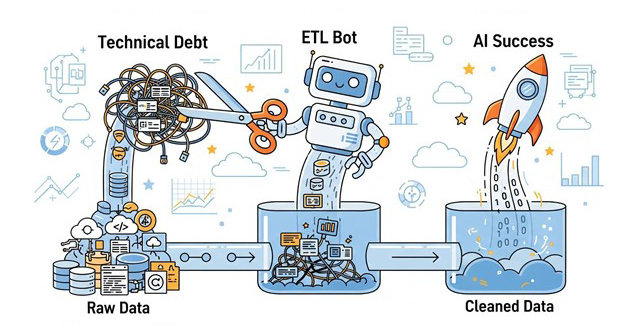
Top 5 Ways ETL Automation Cuts Technical Debt and Accelerates AI Success


Nowadays, the companies are staking big on artificial intelligence and machine learning to derive knowledge in order to remain competitive in a data-driven world. The thing is that in fact, the magic pops out only when the data pipelines, those extract, transform, and load (ETL) processes which feed AI models, are efficient and reliable ones. Making ETL automatic is more than eliminating headaches on data engineers, it is reducing technical debt and accelerating the AI development cycle to access a vault ROI.
It has been proved that in every AI project, the problematic data pipeline is the culprit behind approximately 50 per cent of AI project failure. Technical debt-twisted, old software and procedures slow the work and increase the expenditures. Firms that have automated ETL realize large returns: up to 60 % less data latency and fresher data that increases model accuracy and responsiveness. Here are the top 5 ways ETL automation delivers real ROI and fast-tracks AI success:
1. Faster Machine Learning Model Iteration

Machine learning is all about experimentation and more frequent access to well-vetted clean data can allow teams to test more ideas and tune their models more continuously as well-leading to more intelligent AI. Automated ETL pipelines eliminate manual lags and data prep bottlenecks allowing companies to decrease the model iteration time by up to 40%. As an illustration, a single international company transitioned out of performing weekly data updates to daily data updates as part of ETL automation, reducing model retraining days to hours. It increased their responsiveness to change, and put millions of dollars in better results.
2. Reduction in Technical Debt and Maintenance Costs
Data pipeline technical debt manifests itself in unstable scripts, weaker documentation, and manual flames-putting out all the time-causing downtime and wasted engineering time. Automated ETL platforms encourage design modularity, component reusability, and active monitoring, and makes brittle pipelines reliable. It has also been discovered that automating ETL reduces technical debt and associated maintenance expenses by an approximate percentage of 35 percent of incidences of emergencies and therefore risk that companies using automation learn to avoid. This lets data teams work on exploring new things on an innovation basis and eliminates the necessity to engage in firefighting.

3. Improved Data Freshness Enhances Model Performance
The machine learning models depend on new data- old inputs lead to the drift in the model and low predictions. Near real-time data is made possible with automated ETL, increasing data freshness 50 percent or more compared with batch processing. As another example, a large retailer converted to hourly data loads instead of overnight, and dramatically improved demand forecasts by 20%, reduced stockouts and overstocks, and increased customer satisfaction.
4. Scalability and reduced manpower to save cost Cost Savings

However, manual ETL processes are slow and prone to errors, because they require humans to monitor them all the time. Automation reduces manual labour, and enables flexible consumption of resources- particularly on the cloud. McKinsey claims that automating data engineering decreases the cost of labour associated with data engineering by as much as 25%, and cheaper cloud native pipelines also minimise hardware expenses. This also accelerates the onboarding of new data sources, so that insights are faster, without increasing head-count or infrastructure expenses.
5. Reduced Data Latency Enables Real-Time AI Applications
Applications of AI such as fraud detection and dynamic pricing require real-time data whereas conventional batch ETL works have delays that negatively affect performance. Streaming and micro-batches can be made possible with automation and reduce data latency by 60%+. As one example, an automated event-based ETL allowed a telecom company to detect network problems in real-time time-saving the company millions of dollars in frauds and increasing the level of customer trust.

End View
Automating ETL is not only a productivity tip to the data engineers, but it is more like giving its data pipeline a turbo boost cleanse out the tech debt junk, and present fresh and clean data on a silver platter. It is like the secret sauce that accelerates the brain gains of your AI and saves you in operational costs in your slumber.
With all the automation AI can do, automated ETL is the real MVP: the magic wand that enables businesses to innovate more quickly, avoid becoming victims of data disasters, and gain a competitive edge with the strength of their data muscles as companies sprint toward the future. Who would have expected pipelines to be so show stoppers?
No Techcircle journalist was involved in the creation/production of this content.


